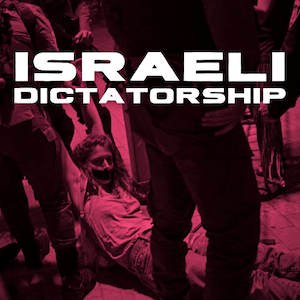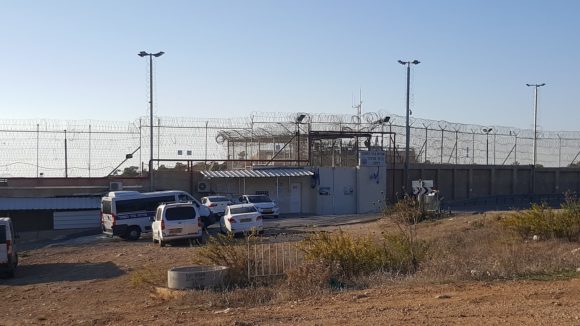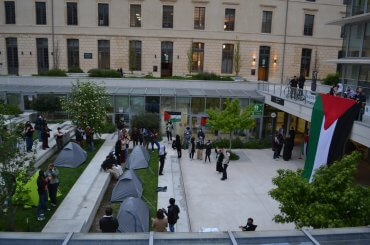
On Friday, December 1, Israel resumed the massive bombardment of Gaza in a campaign that has already been found to be one of the worst and most deadly in modern history by international experts and human rights organizations. Israel blamed Hamas for violating the terms of the prisoner’s exchange. Yet I have seen up close, by following the political trials in Haifa court, how Israel itself has undermined the very basics of what a prisoners’ exchange means. It did this through mass arrests of Palestinians ahead of the prisoner exchange, holding them as “security prisoners” under a definition that was expanded following October 7, and then released them as part of the prisoner exchange — even though Israel had no reason to hold them in prison in the first place. This has been one time when Palestinians inside the Green Line suddenly became a significant part of the larger conflict.
These have been frenzied times for us in ‘48 Palestine, and people here are terrified. Beginning on October 7, as the shock from the attacks turned quickly into an indiscriminate rage, many in the Jewish public turned on their Palestinian co-workers and classmates to expose signs of disloyalty and report them to the authorities. Hundreds have been interrogated and arrested for little more than social media posts. When I asked an apolitical friend in my neighborhood how he was doing, he answered: “I do not see, do not hear, do not speak!” This has continued to this day. Just recently, I visited my corner grocery and people were arguing whether you would be arrested for a “like” or only for sharing a post. As I said, there is fear everywhere.
Political prisoners are an important part of Palestinian life, even in popular culture. Over the last several decades, there has been a significant change in terminology relating to prisoners. In the 1970s and 80s, political activists in ‘48 Palestine spoke about “prisoners” using the same term as the one that is used for criminals and innocent victims of the capitalist system. Even the first association that defended Palestinians in the occupation’s prisons was called “The Prisoner’s Friends.” In the nineties, the Arabic word asir (plural asra, feminine asirah), denoting prisoners of war, became the common term for anybody who was arrested in the context of the struggle for liberation.
Some of the asra were feda’iyeen — guerilla fighters who decided to carry arms and fight against the expropriation of the Palestinian population. Others were asra siyasiyun — hardcore political militants that the regime decided to shut up, like the leadership of Al-Ard, Abna’ al-Balad, and the Islamic movement. To be an asir, despite all the suffering, was in some ways to be part of the political elite. When we speak of the Palestinian asra, we include all those who were arrested as part of the struggle, never mind whether they are from the West Bank, Gaza, ‘48 Palestine, or the diaspora. We also do not distinguish whether they were affiliated with the PLO, other resistance movements, a local organization, or not affiliated at all. Moreover, the term does not distinguish what those asra were accused of, as doing so would mean giving legitimacy to the occupation’s courts, where Palestinians never expect justice.
But the meaning of being a political prisoner changed after October 7.
Take, for example, the case of Mariam (not her real name), a student from a conservative Palestinian family. On October 7, some Jewish students found a mild political post on a Facebook page that carried her name. They complained about her to the Haifa University. Mariam claimed it was not her account and displayed another Facebook account with her name, where she published pictures of her family and relatives. The university management, in addition to taking administrative measures against Mariam, turned her case to the police.
The police arrested Mariam and started an intensive investigation. Their theory was that she held two Facebook pages, one for her conservative family and the other for her university friends. When Mariam denied the allegations, they summoned her friends and acquaintances for interrogation. Even as some other students with similar posts were released, Mariam’s detention was remanded under the claim that if she were released, she could disrupt the investigation. As she was still in prison as a “security prisoner,” she was released in the women’s prisoners’ exchange that took place between Israel and Hamas.
According to Yousef Taha, the head of the Joint Body of Arab Student Blocs in Universities and Colleges, which is the united front of ‘48 Palestinian student organizations, there were seven or eight female students who were detained at the time and were released as part of the prisoner exchange. Each of them was accused of a minor singular social media post, and their cases were not significantly different from those of a dozen students who were released by the courts in the very same period. Up until now, the state has not even abolished the indictments against them, and in some court hearings that I attended, the state’s prosecution declared that they were “studying the situation,” requesting that the hearings be postponed.
To take another example, the case of two young Palestinian women from Haifa who were arrested and indicted for “threats” and “disruption of public order” demonstrates how frivolous charges have been enough to treat arrestees as “security prisoners.” According to the indictment, on October 12, the two women cursed a policewoman with a vulgar message on WhatsApp, and later that day, they called the Haifa police hotline and said, “I am from Gaza, from Palestine, I am Hamas. I am in Haifa to kill all the Jews now.” When arrested, they said they were just joking, but they were kept in detention and later indicted.
These two young women were categorized by the Israeli prison authorities as “security prisoners” and were held in harsh conditions in the Damon prison. One of them was released as part of the prisoner exchange. The other was convicted on December 4 in the Haifa court, and she will stay in security prison for a third month until her formal sentencing.
Here I must clarify that in the Israeli prison system, there is a completely different regime for the more than 7,000 Palestinian “security prisoners,” who are deprived of most of the basic rights of regular prisoners. Many of them are from the West Bank and Gaza, but there are also many of them who are Palestinians with Israeli citizenship.
Many fear that the prisoners who were released in the exchange will now be the object of revenge, even though it was the government’s decision to release them. Adalah and other human rights organizations warned that Israel might try to label all of them as “Hamas supporters” and might even apply new laws for withdrawing their citizenship and basic social rights.
On Monday, it was reported that the Zionist municipality of Jerusalem is preventing released high school students from attending their schools. The Technion announced that a female Palestinian student who was also detained for a Facebook post and later released in the prisoner exchange would “never” be allowed to resume her studies. The university announced this extreme measure, of course, without holding any relevant “disciplinary” proceedings, which would necessitate checking the facts of the case.
More broadly, the arbitrary detention of ‘48 Palestinians for minor infractions and labeling them “security prisoners” — many of whom were later released in the prisoner exchange — has enabled Israel to avoid the release of other “real” Palestinian women security prisoners, who have been serving much longer sentences.
As the prisoner exchange evolved under the pressure of the threat of resuming deadly fire, with new lists of people to be released published every morning, Israel sabotaged the process. Unlike Hamas, which had to collect prisoners from hiding places under severe danger, Israel could easily prepare orderly lists. But what they did instead was to publish a list with hundreds of names, claiming that these were the people who might be released. At the last moment, after Hamas would publish its exact list for the day, they tended to select the prisoners with the least time to spend in prison or detainees who were not even convicted of any offense.
One is left to wonder whether this deliberately underhanded way of handling the prisoner swap is one of the reasons why the whole process broke down.



And there was I naively assuming they were just arresting more Palestinians in the West Bank to ensure there were no cells going to waste after releasing the exchange prisoners; not that they arresting people on trumped-up charges so that they could pretend to be releasing prisoners in exchange for hostages. Silly me!
“Over the past six weeks, there have been more than 3,000 Palestinians from the West Bank and East Jerusalem thrown into detention centers. Palestinians are being locked up at a greater rate than ever before.
For every Palestinian released over the past week, more than ten have been put into detention. This makes a mockery of the so-called hostage swaps that the Western media are reporting.”